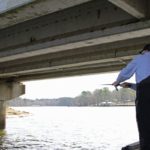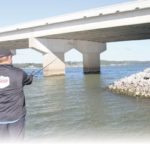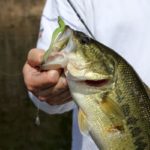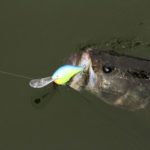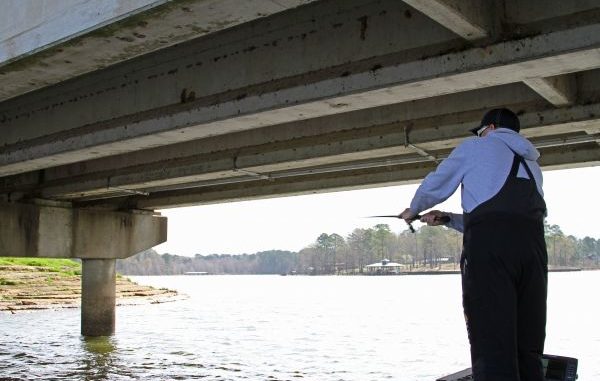
Fall is a time when bass are chasing bait, and that means they can be here today and gone tomorrow. But these pros tell how to find consistency by focusing on current-funneling bridges.
The fall feeding frenzy is always an exciting time for bass anglers, as gluttonous green fish motivated by winter’s impending approach seem bent on testing their internal capacity.
Largemouth bass will focus their efforts on areas most likely to be heavily laden with shad, and when autumn’s crisp coolness falls fresh upon a lake, one of the best places to find feeding fish is the nearest bridge.
Any bridge — large or small — will do, but those crossing major creek arms will see noticeably higher activity, as these are the annual migration routes bait schools follow.
Fall is a time of constant movement, so don’t be surprised if the action has a here-today, gone-tomorrow vibe. But on the upside, large bait schools rarely hide for long, and blending a diligent watch for those sonar blobs with an eye to the surface will help you dial in your focus.
Here are some thoughts by touring pros that can help you put together key bites during this time of dynamic changes.
The attraction
As FLW regional pro Phil Marks pointed out, seasonal drawdowns create current that’s deflected, redirected and funneled by bridge pilings. Bassmaster Elite Series pro Dennis Tietje agreed, and noted that wind can yield similar water movement.
In any case, whenever water moves through narrowing confines, the result is a situation upon which bass will capitalize.
From Toledo Bend to the Red River to lakes Calcasieu and Henderson, Tietje said that, while bridges retain the same general attractions — shelter, shade, ambush points — as they do other times of the year, these man-made crossings increase in strategic value each fall by assisting the bass in their frantic feeding fixation much the same way the sideline benefits defensive backs seeking to corral a swift ball carrier.
“Typically, this time of year the bait starts balling up, and bridges are pinch points where all that bait that’s heading back to the creeks gets funneled through a tight area,” Tietje said. “As that bait washes past, those bridge pilings make a current break, and the bass will position on the downcurrent side to ambush baitfish as they pass by.
“In lakes, that’s a consistent (scenario), but in tidal waters that will change. The fish may be on the south side of the bridge in the morning, but they may be on the south side in the afternoon. So paying attention to your tide schedule, and current flow is the main deal.”
Areas and variables
As Tietje observed, the biggest challenge for most bridge neophytes is trying to find a starting point.
First of all, you’ll rarely need to fish every inch of the structure; instead, understanding the key pieces will facilitate planning.
In the proverbial nutshell, look at bridges in three pieces: the center channel zone, where the deepest water provides the greatest temperature moderation; the outer pilings that provide multiple targets where fish can avoid the heavily trafficked waters, and slide up and down the structures as needed; and the riprap lining the causeway and bridge embankment.
Some anglers start deep and then move shallow, while others prefer working shallow to deep. It’s essentially a personal preference, as long as you make bait location the priority.
But daily atmospheric conditions bear great impact on bridge bass. Fish are more given to roaming during cloudy periods, while sunny skies generally send them lower in the water column or into shadowy areas.
But as Tietje pointed out, the fall feeding instinct might find bass tolerating a little squinting for the sake of filling their bellies.
“Just because it’s sunny doesn’t mean all the bass will be down deep,” he said. “If the shad are out in the sun, the bass will be, too.
“They’ll take a breather and use those shadow lines, but in the fall I think the sun has less to do with (bass) positioning than where the bait is.”
Also pay attention to wind. An often-significant source of lake current, the sheer force of fall wind tends to drive bait schools toward the hard lines. Essentially, a good blow will move loads of shad onto that riprap, where bass will gladly gorge themselves.
“When there are areas of riprap, it forms a structure line for the shad to migrate back and forth,” Tietje said. “A lot of times you can get on that line early, when the shad are up high, and stay on then.
“Windy days increase the attraction by forcing plankton up on the shoreline and loosening the algae that baitfish eat. Anytime you mass up the balls of bait on a shoreline it will concentrate the bass because it’s a target-rich environment.”
But Bassmaster Elite Series pro Jason Christie said the current day’s wind conditions are not the only consideration.
“You might have a calm fall day, but the day before, it was blowing,” Christie said. “That’s why I pay attention to not only the current day’s conditions but also how the wind was blowing the previous day.
“I try to fish those area that were catching the wind, because there’s going to be a lot of bait packed in there.”
Bait selection
The good thing about bridges is that the diversity of where you might find your fall bass means there’s not much you can cross off the try-it list.
In fact, Christie said autumn efforts are often defined as pure junk fishing.
“I probably have more rods on my deck in the fall than any other time of year,” he said.
That being said, a handful of logical options usually percolate to the top, Tietje said.
“I like to approach a bridge first with a moving bait — either a ¼-ounce Strike King Redeye Shad, or a KVD 1.5 squarebill,” he said. “If that doesn’t work, I’ll go to a Strike King KVD jerkbait, and then if that doesn’t work I’ll go to the bottom with a Texas-rigged worm, a dropshot or a 3/8-ounce Strike King heavy-hook football jig.
“For the jig, I like green pumpkin, peanut butter and jelly, or black/blue with a Strike King Rage Chunk.”
His choice of jig trailer isn’t random, either.
“I like the chunk trailer because it keeps the jig in a small profile,” Tietje said. “I’ll trim the skirt to the bottom of the hook to minimize that profile, because you catch a mix of big and small fish in the fall.”
Tietje said he’s also fond of burning a ¼-ounce spinnerbait along the riprap when the bait gathers shallow. Get those willow leaf blades flashing and bass just can’t help themselves.
Fast-paced presentations are the key — make bass decide in a split second to react or miss a meal.
For shallower pilings, as well as that riprap fortifying bridges’ landward ends and their related causeways, Toledo Bend guide Stephen Johnston likes a V&M Lightning Blade swim jig with a shad tail swimbait trailer.
Russel Cecil, an FLW regional standout with lots of time on Toledo Bend and other western Louisiana fisheries, uses a one-two punch for the rocky mounds.
“I’ll fish the causeway riprap with a shad-colored Bandit 200 squarebill crankbait,” Cecil said. “But if it’s windy and rainy, I’ll use a buzz bait.”
Out deeper, near the main channel, Cecil likes a Texas-rigged worm, but if the bridge has cross members, he’ll pull out a deep-diving crankbait. Here, the name of the game is contact — just like bumping wood in a shallow stump field, only deeper.
“I’ll try to bounce the crankbait off the cross members for a reaction strike,” he said. “The fish are usually 8 to 12 feet deep, depending on the bridge and the water levels.”
When Johnston’s working a bridge’s deeper zones, one of his top tactics involves slow-rolling a ½-ounce spinnerbait with hefty willows around the pilings.
Tracing the face of a piling usually does a little better than open-water retrieves, but he’ll also work the gaps between sets of pilings in case a fish is chasing shad out that way.
Marks is also a big fan of spinnerbaits — particularly for the suspended bass.
However, when he’s looking for deeper fish, he’ll often work the sides of the bridge pilings with a 3/16-ounce Strike King Tour Grade shaky head with a KVD Fat Baby finesse worm.
A shaky head is one of the most-versatile baits for structure fishing because you can cast it, skip it, slow drag it or just let it sit next to a piling and wiggle in the current until it finds a taker.
Now, FLW Tour pro John Murray has an interesting bridge technique.
An accomplished drop-shot innovator, Murray will cast his bait across the upcurrent side of a piling and let it come tight against the concrete face. Often sliding down just past that upcurrent face, he’ll use his trolling motor to hold his boat in position while he works his rod tip to impart subtle action on the drop-shot.
“The current holds the drop-shot up against the piling, and when I wiggle the rig the worm looks like a baitfish feeding on bridge algae,” he said. “Square pilings are easier to wrap around, and you have to use braid to avoid breaking your line.”
